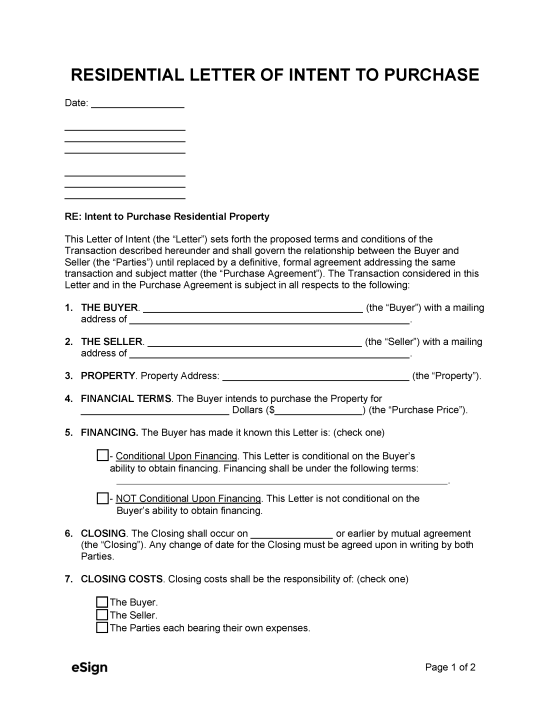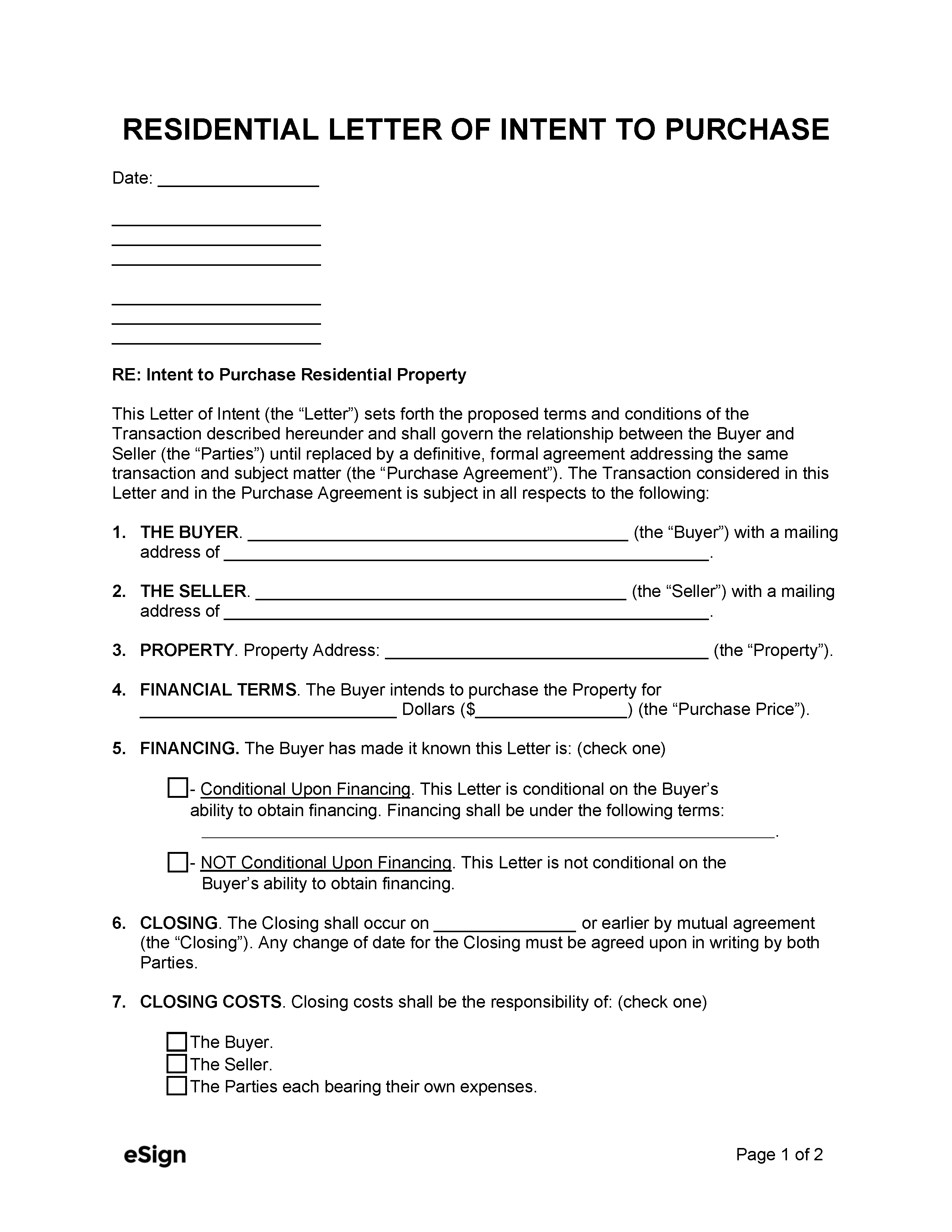A residential letter of intent (LOI) to purchase is used by interested home buyers to begin the negotiation process with a property seller. The letter relays the buyer’s intention and financial offer to purchase the seller’s property. If the seller signs the letter, they agree to work towards a definitive purchase contract with the buyer.
Commonly Used With
- Residential Property Disclosure – Given to potential buyers to provide them with an overview of any past and current issues with the property.
- Residential Sale & Purchase Agreement (SPA) – Confirms the details laid out in the letter of intent and creates a binding obligation to purchase as long as all contingencies are met.
Contents |
What’s Included
An LOI to purchase residential property will look a lot like a purchase contract. However, its terms are generally non-binding and simplified. The letter will often contain the information listed below.
- Introduction – A letter of intent begins with a brief introduction that states the buyer’s intention to enter an agreement to purchase the seller’s property.
- Names and addresses of buyer and seller – Both parties must be clearly identified along with their addresses.
- Transaction description – The property address and buyer’s offer will need to be included as the fundamental details of the transaction. The original offer may be negotiated and amended multiple times before a purchase contract is signed.
- Financing – Buyers will often need to obtain financing to afford a home. If financing is required, this should be clarified at the outset in the LOI.
- Closing terms – Closing is the date on which property ownership will be transferred to the buyer. The letter can specify the closing date and which party or parties will be responsible for any closing costs.
- Property inspection – The buyer will usually demand to do an inspection of the premises before they consider signing a purchase agreement; this requirement will generally be relayed in the LOI as well.
- Standstill agreement – Real estate LOIs will often prohibit the seller from negotiating to sell the property to any other party until the LOI is terminated. This provision temporarily gives the buyer the exclusive right to purchase, provided they sign the letter.
- Signatures – The buyer and seller will need to sign the document to affirm their intention to proceed in good faith and not pursue other buyers. Depending on the structure and terms of the letter, its contents may or may not be legally binding once it’s signed.
Sample
Download: PDF, Word (.docx), OpenDocument
RESIDENTIAL LETTER OF INTENT TO PURCHASE
Date: [DATE]
[SENDER (i.e., BUYER) NAME]
[SENDER STREET ADDRESS]
[SENDER CITY, STATE, ZIP]
[RECIPIENT (i.e., SELLER) NAME]
[RECIPIENT STREET ADDRESS]
[RECIPIENT CITY, STATE, ZIP]
RE: Intent to Purchase Property
This Letter of Intent (the “Letter”) sets forth the proposed terms and conditions of the transaction described hereunder and shall govern the relationship between the Buyer and Seller (the “Parties”) until replaced by a definitive, formal agreement addressing the same transaction and subject matter (the “Definitive Agreement”). The transaction considered in this Letter and in the Definitive Agreement is subject in all respects to the following:
Please note: Any sections that do not apply may be struck through or deleted.
1. THE BUYER. [BUYER NAME] (the “Buyer”) with a mailing address of [BUYER MAILING ADDRESS].
2. THE SELLER. [SELLER NAME] (the “Seller”) with a mailing address of [SELLER MAILING ADDRESS].
3. TRANSACTION This Letter is for the purchase of the Property located at [PROPERTY ADDRESS] (the “Property”) for $[AMOUNT] (the “Purchase Price”).
4. FINANCING. This Letter is: ☐ – Conditional Upon Financing ☐ – Not Conditional Upon Financing.
5. CLOSING. The Closing shall occur on [DATE] (the “Closing”). Any change of date for the Closing must be agreed upon in writing by both Parties.
6. CLOSING COSTS. All costs associated with the Closing shall be the responsibility of (check one) ☐ the Buyer ☐ the Seller ☐ the Parties each bearing their own expenses.
7. POSSESSION. Possession of the Property shall be given on [DATE] (the “Possession”). Any change of date for the Possession must be agreed upon in writing by the Buyer and Seller.
8. STANDSTILL AGREEMENT. Following the execution of this Letter, and until Closing, the Seller shall not negotiate for the sale of the Property with any other party unless either the Parties agree in writing to terminate this Letter, or the Parties fail to sign a Purchase Agreement by [DATE].
9. INTENTION OF THE PARTIES. This Letter sets forth the intentions of the Parties to use reasonable efforts to negotiate, in good faith, a Definitive Agreement with respect to all matters herein. Notwithstanding paragraphs 4 and 8 through 11, which shall be legally binding, any legal obligations with respect to all other matters shall only arise if and when the Parties execute and deliver a Definitive Agreement.
10. GOVERNING LAW. This Letter shall be governed under the laws of the State of [STATE NAME].
11. SIGNATURES.
Seller Signature: ____________________________
Date: [MM/DD/YYYY] Print Name: [SELLER PRINTED NAME]
Buyer Signature: ____________________________
Date: [MM/DD/YYYY] Print Name: [BUYER PRINTED NAME]
How to Use
The buyer will usually visit the property and discuss terms with the seller before they draft their letter of intent. An LOI that has been signed by both parties represents their intention to reach a definitive agreement. The LOI allows the buyer and seller to negotiate through a non-binding agreement that can be terminated at any time. Also, if it’s a standstill agreement, the buyer can negotiate and make a purchase contract without the risk of being undercut by another buyer.

